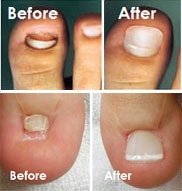This year for falls awareness week, the theme is healthy feet.
It is estimated that 1 in 3 people aged over 65 fall each year.
The consequences can be devastating.
Accidents can happen so easily, but many falls can be avoided by wearing correctly fitted, supportive footwear around the home. It's natural to want the comfort, warmth and easy access of slippers. Most falls that older people experience however happen within the home and such falls are often due to poorly fitting footwear, with little or no support.
 It's not just women who feel ashamed of thick and unsightly toe nails! many men do too!
It's not just women who feel ashamed of thick and unsightly toe nails! many men do too!
Fungal infection, injury and the effects of poor health can cause nails to become unsighlty. When we decide to take a well deserved holiday in the sun, on the beach....what is it that we want to do?.....yes.....expose our feet....but many men wont because they feel self- conscious of their toe nails.
We have carried out many gel nail repair and reconstructions for men going on holiday. THE RESULT: A more enjoyable holiday!
So come on men, dont be shy....let us improve how your nails look and no more hiding your feet!
So of course you do, we love shoes, don’t we ladies? (and men of course!) but so many mistakes over the years, so many shoes stuffed in the cupboard hidden away.
Why are they so uncomfortable?
'Hey but they look so good!'
The answer to avoiding these pitfalls is very simple.
- Know your foot type.
- Know your arch type.
- Know your pressure points.
- Know your foot size. (So many people unsure as feet change shape and size over time)
Armed with this information you will always be walking pain free.
A foot scan will be able to identify your foot type.
Always think 'the right shoe for the right job' so ladies (and men) you can wear those fancy high shoes but please don’t walk too far in them.
They are your “sitting and looking fab” shoes.
Happy Walking and looking good.
“Please help me I have plantar fasciitis and the pain is stopping me dancing."
I went to See Sushila in 2010 and she prescribed some orthotics to help with the foot pain and I also bought some black patent sandals.
My foot pain got better and I have danced and danced to funk jazz music in the sandals for 3 years.
Thank you, Sushila.I will be back for more dancing shoes.”
Gill Wilson 13th May 2013
During the spring and summer months the skin around the heels can become dehydrated, hard and flaky due to sandal wear.
Heel fissures, also known as cracked heels, can be a cosmetic problem but can also be painful, bleed and lead to serious medical problems if infection enters the broken skin.
Heel fissures can affect anyone, but risk factors include: living in a dry climate, being overweight, walking barefoot or wearing sandals or open-backed shoes. Diabetes, poor circulation and inactive sweat glands can also be predisposing factors, it is essential in these cases to have podiatric care to prevent further problems.
Treatment and Prevention
Filing the heels using a foot file ( NOT a harse 'cheese grater type file) before a shower or bath can help to decrease the thick and flaky layer of skin, daily application of a suitable heel balm or foot moisturiser will help prevent dehydration and keep the skin supple and elastic. Avoid going barefoot or wearing open-backed shoes, sandals or shoes with thin soles. Shoes with good heel shock absorption can help to improve the condition.
If you are unable to resolve the condition then a visit to your podiatrist can help manage the problem, prevent complications and help the skin around the heels look much healthier!
"I visited the practice after suffering severe heel pain. After just one consultation, assessment, treatment and some very good advice; I am now pain free. I made purchases of shoes, slippers and orthotic insoles, which were all in stock. Altogether I am extremely pleased with the service and attention that I received."
Dave Hill Harold Hill Romford
Heel pain is one of the most common conditions which we treat, it is debilitating, distressing and disrupts all areas daily life.
There are many types of heel pain, the most common is plantar fasciitis which is an inflammation of the ligaments under the foot and usually occurs due to stresses and sprain of the ligaments under the foot.
Common underlying causes are a combination of poor mechanical foot function, tight achilles tendons and unsuitable footwear.
Painkillers and steroid injections can help control pain but do not address underlying causes and the pain can return.
There are many podiatric treatments for heel pain, from our experience the best way of gaining not just short term relief but prevention of recurrences is by finding as many causes as possible and designing a treatment plan aimed at eliminating as many as possible.
If you have heel pain you do not need to accept and put up with it....there is help!
 As we age the skin on our feet is prone to drying out.
As we age the skin on our feet is prone to drying out.
Applying a good moisturiser is essential as part of your daily routine.
The secret to a good moisturiser is not necessarily the price.
There is not a direct correlation between how expensive a good cream is to its effectiveness.
Read the ingredients.
As a general rule it is best to look out for creams that do not contain alcohol or alcohol derivatives.
Alcohol can hinder the absorption of the cream into your feet.
Good foot creams are those without alcohol so these can be thicker and gooier but they will work best if applied daily.
There are many lotions and potions out there to choose from so if you are confused a Podiatrist will help you choose the right cream for you.
Do you suffer with dry skin on your feet?
Moisturise, Moisturise, Moisturise.
Our feet work and walk hard.
On average you walk seven to ten miles a day.
With each step two and a half times your body weight comes down on each foot.
Apply moisturiser to your feet daily.
Dry skin can be unsightly and it can crack open and become infected and painful especially in diabetics and people with poor circulation.
We recommend applying the cream at night.
A good idea is to massage the cream into your feet about an hour before going to bed and putting on a pair of trainer socks which will allow the absorption of the cream into your feet.
However the socks should be taken of before going to bed.
So many creams to choose from.
Next time
The secret to a good moisturiser.
Latest Tips
- The Complete Guide to Footwear: Choosing the Right Shoes for Every Occasion
- How is Your Socks Life?
- What is Swift Microwave Therapy?
- We are Open!
- Is your ingrown nail a right pain the foot ?
- We are committed to keeping you safe
- Exercising in Lockdown
- Coronavirus Update
- Goodbye, We will miss you Sandra
- National receptionists day
What People Say
-
So it was Plantar Fasciitis!
My feet were so painful I couldn't stand when I got up out of bed. ...
-
I no longer experience pain when walking
The treatment I received from Anita was of the highest professional...


